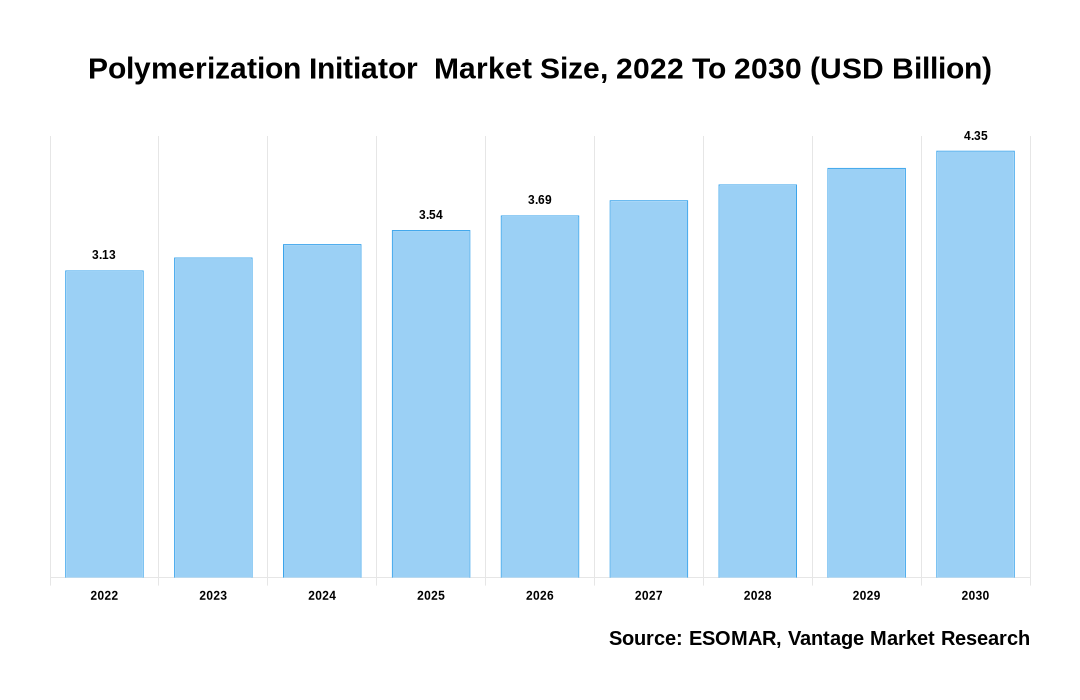
Polymerization Initiator Market
Polymerization Initiator Market - Global Industry Assessment & Forecast
Segments Covered
By Type Persulfate, Peroxides, Azo Compounds, Active Species, Free-radical, Cationic, Anionic
By Application Polyethylene, Polypropylene, PVC, Polystyrene, ABS
By Region North America, Europe, Asia Pacific, Middle East & Africa, Latin America
Snapshot
| 2022 | |
| 2023 - 2030 | |
| 2017 - 2021 | |
| USD 3.13 Billion | |
| USD 4.35 Billion | |
| 4.20% | |
| Asia Pacific | |
| Asia Pacific |
Customization Offered
Cross-segment Market Size and Analysis for Mentioned Segments
Additional Company Profiles (Upto 5 With No Cost)
Additional Countries (Apart From Mentioned Countries)
Country/Region-specific Report
Go To Market Strategy
Region Specific Market Dynamics
Region Level Market Share
Import Export Analysis
Production Analysis
Others Request Customization Speak To Analyst

Polymerization Initiator Market: By Type, Active Species, Application, and Region
Market Synopsis:
Global Polymerization Initiator market is valued at USD 3.13 Billion in 2022 and is projected to attain a value of USD 4.35 Billion by 2030 at a CAGR of 4.20% during the forecast period, 2022–2028. Polymerization Initiator is used commercially for the production of thermoplastic elastomer, which has emerged as one of the key product application areas. However, elastomers are not the only application for this product. Polymerization Initiator s are also used in chemicals and cosmetics industries to make a variety of products such as varnishes, lacquers, surface coatings, paper coating emulsion paints and photoresists.
Polymerization Initiator Market Size, 2022 To 2030 (USD Billion)
AI (GPT) is here !!! Ask questions about Polymerization Initiator Market
Increasing Demand for Polymerization Initiator in Production of Thermoplastic to Drive Market Growth
The growth in the number of applications for thermoplastic polymers has increased the demand for Polymerization Initiator . In addition, the increasing market share of biodegradable plastics has been another factor that has fueled growth in demand. The end use industries such as automotive, electrical & electronics and consumer goods are expected to witness high growth rates during the forecast period as consumers are increasingly buying these products with growing disposable income and improving lifestyle. The growth is further supported by the increasing demand for biodegradable polymers. The rise in government initiatives to introduce new/ stringent environmental regulations also contribute to the market growth. However, volatile raw material prices and availability of substitutes may hamper the market growth during forecast period.


Report Coverage & Deliverables
- Real-Time Data Updates:
- Competitor Benchmarking
- Market Trends Heatmap
- Custom Research Queries
- Market Sentiment Analysis
- Demographic and Geographic Insights
Get Access Now
Market Segmentation:
The global Polymerization Initiator market is segmented by type (Persulfate, Peroxides, Azo Compounds), Active Species (Free-radical, Cationic, Anionic), Application (Polyethylene, Polypropylene, PVC, Polystyrene, ABS), and Region.
By Type, Peroxides to Dominate the Global Polymerization Initiator Market
The major types of commercial initiators include peroxides, azo compounds and others. Of these the peroxide family is estimated to account for more than 40% of total demand. In terms of growth rate, however, azo group is expected to be the fastest-growing segment during the forecast period. The reason behind this trend includes increasing usage in various emerging fields such as nanocomposites & 3D printing which is driving overall demand further at a healthy CAGR of 3.3%.
This is expected to be driven by factors such as increasing consumer inclination towards the usage of peroxide-based Polymerization Initiator s for better efficiency, durability, and quality of end products. This trend is anticipated to remain strong in the forecast period owing to improving living standards among consumers across North America and Asia Pacific leading to growing demand of new applications including electronics & automotive components, footwear & accessories etc.
Asia Pacific is the Largest Consumer in the Global Polymerization Initiator Market
Asia Pacific is the largest consumer and producer of Polymerization Initiator . As of 2021, the region has over 20 countries housing prominent manufacturing companies of Polymerization Initiator s, where most suppliers are located at China, Japan and India. Many manufacturers located at Japan producing adhesion promoter (silyl ketene acetal) to prepare food contact coatings on paper packaging materials. The demand for Polymerization Initiator is strong in automotive industry for the production of thermoplastic.
Key Players:
Some of the leading players in the global market are Arkema (France), BASF (Germany), Celanese (US), AkzoNobel (Netherlands), United Initiators (Germany), Adeka Corporation (Japan), and LANXESS (Germany).
The Polymerization Initiator is Segmented as Follows:
Parameter
Details
Segments Covered
By Type
By Application
By Region
Regions & Countries Covered
Companies Covered
Report Coverage
Market growth drivers, restraints, opportunities, Porter’s five forces analysis, PEST
analysis, value chain analysis, regulatory landscape, technology landscape, patent analysis, market
attractiveness analysis by segments and North America, company market share analysis, and COVID-19
impact analysis
Pricing and purchase options
Avail of customized purchase options to meet your exact research needs. Explore purchase options
 Vantage Market
Research | 21-Jan-2022
Vantage Market
Research | 21-Jan-2022
FAQ
Frequently Asked Question
What is the global demand for Polymerization Initiator in terms of revenue?
-
The global Polymerization Initiator valued at USD 3.13 Billion in 2022 and is expected to reach USD 4.35 Billion in 2030 growing at a CAGR of 4.20%.
Which are the prominent players in the market?
-
The prominent players in the market are Arkema (France), BASF (Germany), Celanese (US), AkzoNobel (Netherlands), United Initiators (Germany), Adeka Corporation (Japan), and LANXESS (Germany)..
At what CAGR is the market projected to grow within the forecast period?
-
The market is project to grow at a CAGR of 4.20% between 2023 and 2030.
What are the driving factors fueling the growth of the market.
-
The driving factors of the Polymerization Initiator include
- Increasing R&D Activities to Improve the Polymerization Processes
Which region accounted for the largest share in the market?
-
Asia Pacific was the leading regional segment of the Polymerization Initiator in 2022.



